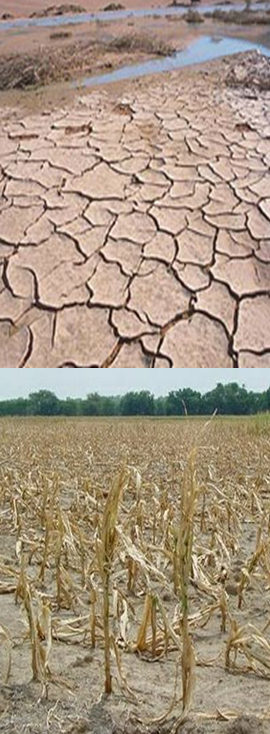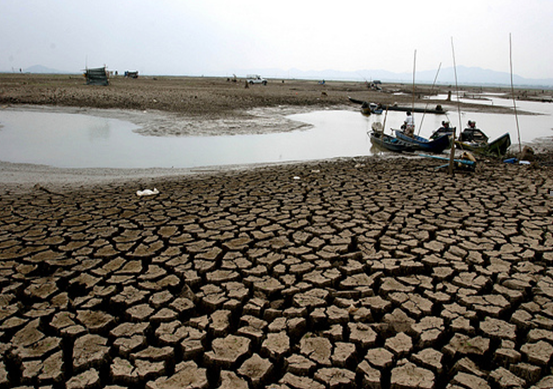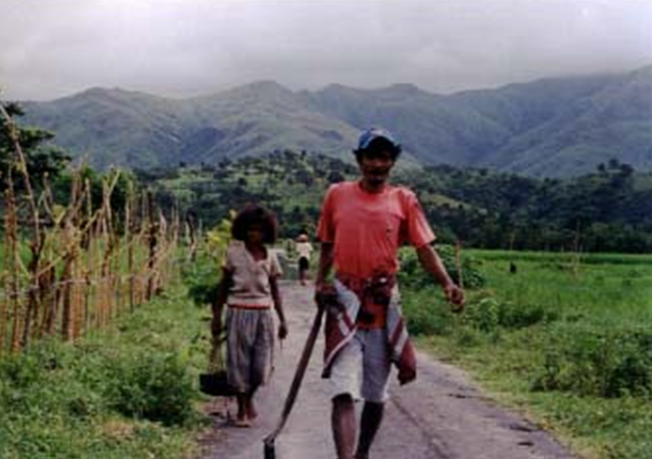(originally published: 2021/01/27)
General Situation
The Philippines has experienced temperature spikes brought about by climate change. It has been observed that warming is experienced most in the northern and southern regions of the country, while Metro Manila has warmed less than most parts. In addition, the regions that have warmed the most (northern Luzon, Mindanao) have also dried the most.
Hot days and hot nights have become more frequent. Extreme weather events have also occurred more frequently since 1980. These include deadly and damaging typhoons, floods, landslides, severe El Niño and La Niña events, drought, and forest fires. Adversely affected sectors include fisheries and agriculture, forestry and health.
The schematic diagram shown as shown in the figure on the right is the ecosystem of an upland community which has already become fragile and exhibits a troubled balance of biodiversity.
The fragility is more evident in that the original dominant dipterocarp species of which so many depend on are biologically difficult to propagate owing to their long flowering and seedling cycles. Environmental problems occurring in the upland manifest themselves as environmental and economic stresses in the downstream. These result in silted rivers, streams and irrigation structures, flooding, pollution of coral reef ecosystem, loss of forest cover, loss of soil leading to higher rainfall runoff, lower infiltration rates, increased sediment flows, landslides and lowered watersheds. Major causes of destruction are logging, mining, charcoal making, and agricultural practices which exacerbates soil loss.


Climate change is the most serious, most pervasive environmental threat the world has face. The "perfect storm" is a convergence of humanity's improvident past, its difficult present, and its uncertain future. The issues are not merely scientific; climate change spans political, social, and economic dimensions, crosses national boundaries, and will impact future generations in a crisis of global proportions.
However, even with the current situation of climate change, farmers try to survive. Intense heat is drying up farmlands, reservoirs and waterways all over the country, and farmers are scrambling to find ways to cope and survive.
EFFECTS, THREAT AND CHALLENGES
The following are the salient effects, threat and challenges voiced by the farmers during the Central Luzon Consultation/Workshop on Agrarian Reform in the Face of Climate Change. The workshop was conducted last March 9, 2010 by the Project Development Institute (PDI). It was attended by the Nagkakaisang Magsasaka ng Gitnanang Luzon (NMGL), other peasant organizations and the government sector.
Pampanga and Nueva Ecija
In Pampanga, Mayor Jerry Pelayo of Canadaba town asked farmers to avoid planting rice and resort to growing vegetables, like eggplant, squash and water-melon, which use less water.
In Nueva Ecija, rice farmers in the western part of Guimba town and nearby towns of Cuyapo, Nampicuan and Talugtog will not be using underground irrigation water because they could not afford the high cost of fuel needed to run the pumps.
Bulacan
In Bulacan, Gloria Carillo, Provincial Agriculturist, said palay planted in more than 1,200 hectares of farms in the towns of Bocaue, Balagtas, San Idelfonso and Calumpit have been destroyed due to the shortage of irrigation water.
Rice fields in Bulacan, Pulilan, Guiguinto and Plaridel towns, have also been drying up.
The Department of Agriculture, Carillo said, will distribute seeds of alternative crops to the farmers to help them recover their losses.
Botolan
“In Botolan, Zambales, 11 Barangays devoted to agriculture were devastated by typhoon Ondoy and by increased sediment flows and downstream flooding from Mt. Pinatubo”, reported Carlito Domulot Sr., an Aeta farmer. He continues to say that “Dry seasons are characterized by the withering of plants especially in the grasslands. This scenario was supposed every four (4) years, but since the start of 2010 (which was not happened to be a drought year) we have experienced an extreme rise in temperature.”
Aurora
Farmers in Aurora shared their observations regarding the continually increasing weather temperature over the past years and up to the present, “dati malamig hanggang 9 ng umaga. … ngayon 8 a.m. pa lang matindi na ang init”. This has affected their work load because “dati ay nakakatrabaho ang kalabaw hanggang 9 ng umaga, ngayon ay hindi na”.
Bataan
Depletion of forest resources affects the food chain in the ecosystem. An example cited by farmers in Bataan is the loss of vegetation cover in the mountains which affects the availability of food for the honey bees which in turn deplete the hives which are the primary source of honey for the Aetas who use it for food and medicine. In dry seasons, honey bees, birds and other useful creatures of the forest migrate to deeper parts of the forest in search of food and a comfortable environment. This makes hunting for food more difficult.

Impact on bio-physical and economic condition
The following bio-physical and economic condition of the climatological changes in the face of surviving agriculture have most severe impact to damage ecosystem, resulting to shortage of water supplies, threaten food production reduce sanitation and hinder economic development:
- Losses in Agricultural Productivity
Erosion accounts for major looses in agricultural productivity in terms of upstream and downstream costs. Upstream costs are usually measured in terms of decline in soil productivity and nutrients are lost and structural properties (like moisture retention) are degraded. Downstream costs consist of current reductions in agricultural due to siltation of reservoir and channels used for irrigation and power generation.
- Loss of Biodiversity
The destruction of much of the farmlands and forests over-exploitation of particular plant have threatened the country’s genetic resources, by using hundred varieties of rice, including some wild species. Increase genetic uniformity through the planting of a limited number of high yield varieties has threatened the rural farms communities’ genetic diversity and increased the likelihood of crop vulnerability to pest and diseases. The high rates of fertilizer application have unfavorable impacts on soil fertility. Such practice has increased soil acidity in many parts of the rural communities and caused soil deterioration. It has spawned other problems, primarily water pollution.
- Soil Erosion and Sedimentation
Soil erosion results in loss soil nutrients, the top soil, or even the entire soil to river channel and the open sea. It also results in sedimentation of rivers, lakes, dams, irrigation canals and other waterways. Lowland farms also suffer low crop yields or destruction of crop as a result of siltation.
Aside from soil erosion, the capacity of the soil to hold water deteriorated with forest destruction. Further, this climate change and global warming impacts reduce groundwater in various farms throughout the farmers’ communities.
- Damming Rivers for Reservoir
Excessive water withdrawal contributes to other environmental problems. In addition to displacement of farmers and flooding farmlands, damming rivers for reservoirs alters the mix of fresh and salt water in estuaries, influence coastal stability by affecting sedimentation and transform fisheries spawning grounds and river hydrology. When grounds water is drawn off at a rate faster than the rate of natural recharge, the water table falls.

Responses
The specific concern is that those who would be a part of the surviving the lives of the farmers in the face agriculture for development today may by making future generations worse off by degrading the earth’s resources and polluting the earth’s environment. Likewise, meeting the needs of the farmers in these generations is an extremely important aspect of environmental sustainability meeting the needs of subsequent generations.
Solutions do exist, but there is an urgent need for an integrated Adaptation-Mitigation framework that will ensure the effectiveness of these solutions. Adaptation and Mitigation are not mutually exclusive, so the most effective way that these strategies can be maximized in the context of surviving agriculture in the face of climate change for development is to integrate adaptation and mitigation.
For the country to weather the perfect storm that is climate change, it needs to act, and the time to act is now towards development and production on the quality of air, land, water, and natural ecosystems; and the need to sustain, restore and improve the productivity of agriculture for the economic well-being of the rural/upland farmers.
The strategy would be less mitigation for greater climatic change, and consequently requiring more adaptation is the basis for urgency reduction in greenhouse gases. Climate mitigation and adaptation should not be seen as alternative to each other, as they are not discrete activities but rather a combined set of action in an overall strategy to reduce greenhouse gas emission. The proposed interventions and strategies are the following:
- Undertake massive tree planting of at least every provincial 50 percent of the mountain range and rural areas at the local level;
- Undertake Program Management - - NGOs have attained a marked dominance in the field of local mobilizing and even administering local affairs; these are seen in their monitoring as well as implementation of community development projects.
- Undertake community oriented programs and project requiring adaptation with reduction in green house gases;
- Advocacy and lobbying- - with their sensitive to the needs of the local people, their dynamism and ability to organize the local communities, NGOs find strength in publicly encouraging people to support and proposed program reform or development agenda on the environmental natural ecosystem.
- We must zealously protect the remain forest from mining, charcoal making;
- We must conduct a vigorous campaign to cut down green house emission not only the first world countries but also to our urban centers as well.
- Farmers and other sectors – How can contribute to a better understanding of the situation of climate change and global warming, and of the role they play and can play in rural development, order to move towards harnessing their full potential as distinct actor in the agrarian reform and the protection of environmental development process?
- Government (DAR, DENR, BFAR and DA)
The Government plays a very important role in the management of natural resources. More often, it is the legal/official owner of such resources and it regulates their allocation by defining their legal framework and through policies that specify obligation and benefits of other resources users.
The Government is likewise responsible for extending assistance and exerting a directing influence on the community and private sector to facilitate constructive action and promote environmental sustainability in these areas.
The Government is in the best position to play the lead role in the process of change and redirection since it has the necessary machineries and institutional strength to effects results.
It is essential for the Government to provide leadership and create the conditions in which vigorous economic activity can progressively reduce the demands and burdens placed on the natural ecosystem which are necessary for human survival and progress.
In Government programmes, the following elements should not missed out:
- Clear policies which recognize the attitudes and conditions supportive of collaboration at international and national levels are requisites to the global concern for change, aside from national programmes in which participation of public authorities- - central and local- - as well as private sector and individual citizens is encouraged.
- Pro-active programmes for integrating environment aims with economic and social aims in development planning in all phases. This calls for a change of a stance in which measures to safeguard the environment are formulated only after the damage has been done.
- More substantial investment in environment research analysis and monitoring. This element is an essential safeguard against the adoption of wasteful and ineffective measures and is a prime requisite for the accurate evaluation of progress towards clearly defined objectives.
- The overhaul and updating of legislation and procedures for enforcement which regulate the control of pollution and waste and waste products and which promote environmentally sensitive development at all levels of human activity.
The Farmers addresses that the Philippines’ Government priority development concerns: climate change and global warming, restoration and sustainable management of the country’s lowland and upland agricultural farmlands and resources and the alleviation of poverty among the poorest of its rural population – the rural/upland communities. Its overall goal is to respond to climate change and global warming and help mitigate their destructive effects on the lives of the lowland and upland farmers in the Country.
